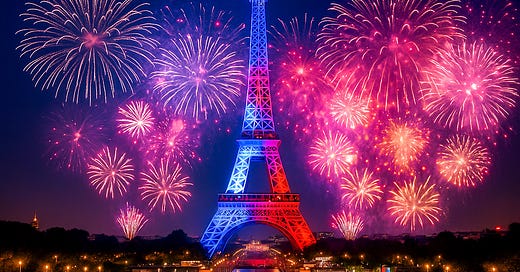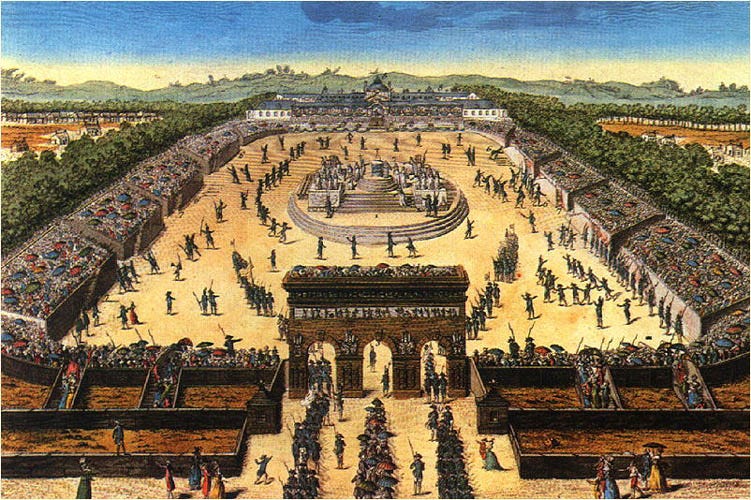How Did Bastille Day Become the Symbol of France?
From storming prisons to dancing in the streets — why the 14th of July still stirs something deep in every French heart.
Bonjour,
Why do the French dance in the streets, light up the sky, and march down the Champs-Élysées with jets roaring overhead?
It’s not just about storming a prison.
Nor is it just about liberté, égalité, fraternité.
Bastille Day — or rather le quatorze juillet, as the French actually call it — is a layered celebration, somewhere between solemn memory and joyful defiance.
And if you’ve ever stood under the Eiffel Tower with half of Paris for the fireworks, you’ll know: it’s not something you forget.
But there’s more to it than meets the eye.
Behind the tricolour flags and accordion-fuelled bals populaires lie two different revolutions, a king who swore an oath he’d soon break, and a ceremony so soaked by rain it almost collapsed — yet still gave birth to a nation.
Why does France celebrate not the Bastille, but something else entirely?
What’s the real story behind that giant military parade?
And why are firemen throwing the best parties in Paris?
To celebrate Bastille Day, this article — usually reserved for paying subscribers — is being shared exceptionally with all my readers.
Because if there’s ever a time to wave the flag and share a little history... it’s today.
🇫🇷 Bonne fête nationale à toutes et à tous !
👇 Read on for the full story — and if you enjoy it, consider subscribing to support future posts in this series on the symbols of modern France.
From Prison Break to Party: What the 14th of July Really Celebrates
Let’s start with a confession: Bastille Day doesn’t actually celebrate the Bastille.
Yes, the fortress was stormed on 14 July 1789.
Yes, it was a pivotal moment in the French Revolution.
And yes, it's a great visual — angry Parisians with pitchforks, smoke rising above the towers, seven prisoners dramatically freed. (One of them was apparently a nobleman who’d gone mad from solitary confinement. Not exactly Les Misérables.)
But the real national celebration — the one that gave birth to le quatorze juillet as we know it — happened a year later, on 14 July 1790.
And it couldn’t have been more different.
That day, under pouring rain, 100,000 people gathered on the Champ-de-Mars, a muddy field outside Paris, to celebrate not a revolution, but a reconciliation.
The event was called la Fête de la Fédération, and it brought together representatives from every French department, King Louis XVI, and a rather soaked crowd of citizens, all swearing loyalty to a new Constitution that was supposed to unite the Nation.
Yes, even the King played along.
He took an oath.
So did La Fayette, hero of the American Revolution, who galloped in on a white horse.
So did every soldier, priest, and baker’s apprentice standing on the soggy field.
They swore to uphold the Nation, the Law… and the King.
It was optimistic. Naïve, even.
But in that brief, rain-drenched moment, it looked like France might actually hold together — monarchy and people, hand in hand, singing patriotic hymns in the mud.
It didn’t last.
A few years later, the King was dead, the Revolution had devoured itself, and France had learned that swearing loyalty doesn’t always end well.
But that day — 14 July 1790 — would remain in memory as the hopeful birth of modern France.
And that’s the day France decided to commemorate, nearly a century later, when the date of the National Holiday was finally chosen in 1880.
Not the prison break. Not the guillotine. But the dream of unity.
A day of oaths, not executions.
Of crowds, not mobs.
Of citizens, not subjects.
Tanks, Trumpets, and Tricolores: The Bastille Day Parade
If you happen to be in Paris on a 14th of July morning, don’t be surprised if you hear fighter jets roaring overhead before your second croissant.
It’s not an air raid. It’s the beginning of the Défilé militaire — the legendary Bastille Day Parade.
Every year since 1880 (with a few exceptions), France puts on its biggest military display right down the spine of Paris.
The Champs-Élysées becomes a catwalk for tanks, helicopters, cavalry units, and impeccably synchronised troops — all marching past the Arc de Triomphe, under the proud gaze of the French President and a host of dignitaries.
It’s a show of strength, of pride, and — let’s be honest — of choreography.
Watching the Patrouille de France (the French equivalent of the Red Arrows or Blue Angels) streak across the Parisian sky in a perfect formation of blue, white, and red smoke is a moment that gives many spectators goosebumps.
Even the most cynical find themselves whispering a quiet cocorico.
But the parade isn’t just a military flex. It’s a stage for diplomacy.
Every year, France invites a guest of honour — often an allied nation — to join the parade.
In recent decades, troops from the UK, Germany, the USA, Japan, Brazil, and even ANZAC contingents from Australia and New Zealand have marched proudly down the Champs-Élysées, side by side with their French counterparts.
In 2023, it was India’s turn, as 240 members of its armed forces joined the parade in celebration of the 25th anniversary of the Indo-French strategic partnership. Even the mighty Rafale jets — built in part through that collaboration — took to the skies together.
Of course, in 2020, there was no parade. COVID had grounded everything — even France’s most iconic public gathering. But in typical French fashion, a pared-down tribute was held at the Place de la Concorde, complete with flyover… and masked guests.
And in 2024, with Paris preparing for the Olympic Games, the parade took a detour. It moved from the Champs-Élysées to Avenue Foch, just for the year. Fewer tourists, more logistics, but the same unmistakable flair.
And after the last tank has rumbled past, and the jets have vanished into the sky?
That’s when the real party begins.
When the Guns Fall Silent… Let the Music Begin
The military might of the morning gives way, almost imperceptibly, to something else entirely.
By mid-afternoon, the Esplanade des Invalides is bustling. Curious children (and not-so-young men) are climbing inside helicopters, patting service dogs, and asking soldiers whether they can try on a beret. The Army opens its doors — and its tanks — to the public. It’s a rare, human moment.
But the real fête begins as night falls.
At 9 pm sharp, the Champ de Mars — that long stretch of green at the foot of the Eiffel Tower — becomes a stage. A grand classical concert brings together the Orchestre National de France, the Chœur de Radio France, and a line-up of world-class soloists.
The music swells, echoing through the avenues, and thousands of people — families, tourists, students, grandparents — sit on picnic blankets, wine in hand, swaying gently under the stars.
Then comes La Marseillaise. Everyone stands. Some sing with shaky voices. Others place a hand on their heart. And for a few minutes, the divisions of everyday life blur into something shared.
At 11 pm — right on time — the sky over Paris explodes in colour.
The fireworks at the Eiffel Tower are among the most spectacular in the world. Thirty minutes of orchestral light and sound, crafted with a precision that would make any pyrotechnician weep with joy.
Each year has its theme (in 2023, it was La Liberté). And each year, new shapes and symbols take form in the sky — tricolores, doves, stars, flames — dancing above the city like the ghost of the revolution itself.
If you’ve never seen it in person, it’s worth the crowds. Worth the wait. Worth the sore feet. Because for half an hour, the skyline becomes a stage for history, beauty, and pure emotion.
And just when you think it’s over… the dancing begins.
Dance Like It’s 1880
When the fireworks end, most countries would call it a night.
Not France.
Here, the 14th of July doesn’t end with a bang, but with a dance — or several, to be precise. Because all over the country, from Paris to the tiniest village, people gather for the most delightfully old-fashioned part of the celebration: the bal du 14 juillet.
Some are held outdoors under strings of lights, others in village squares, fire stations, or community halls.
There might be an accordion player crooning old tunes from the belle époque, or a DJ mixing nostalgic pop hits with unexpected flair. It doesn’t really matter what’s playing — as long as someone’s dancing.
In Paris, the most famous events are the Fire Brigade Balls (Bals des Pompiers). They’ve been a beloved tradition since the 1930s.
On the night of the 13th or 14th, fire stations in nearly every arrondissement open their gates, roll out barrels of beer and cases of rosé, and host a party that’s… well, as lively as you’d expect from off-duty firefighters.
Some balls are free, others ask for a small donation (the famous “pompiers’ kiss” is optional, but quite popular). Either way, the atmosphere is unbeatable: friendly, flirty, a little chaotic — pure Paris.
Elsewhere in France, it’s the same spirit with a local twist.
In coastal towns, you might dance barefoot on the sand. In mountain villages, it’s under wooden chalets with tartiflette wafting through the air. In big cities like Lyon, Marseille or Bordeaux, fireworks reflect on the rivers while crowds sway on bridges and boulevards.
Some communes even hold giant picnics républicains, where neighbours bring wine, cheese and stories — and strangers become friends over a slice of quiche.
It’s not always glamorous. Sometimes it’s raining. Sometimes the speakers don’t work. Sometimes someone brings their dog and it gets tangled in the cables. But that’s the point.
Bastille Day isn’t about perfection — it’s about participation.
It’s about remembering that this Republic — with all its flaws, all its ideals, all its contradictions — belongs to everyone.
From the military general on the Champs-Élysées to the teenager spinning under fairy lights at her village ball.
From the mayor giving a speech to the grandfather clapping along to Joe Dassin.
From Marianne to Charles Trénet.
🇫🇷 Vive la République, Vive la Fête
This year, the Bastille Day parade is back on the Champs-Élysées, and it’s not here to make small talk.
Against the backdrop of global crises — from the war in Ukraine to rising tensions in the Middle East and Asia — France’s armed forces will march in full combat gear.
Helmets, body armour, tactical uniforms. No bayonets for show this time: it’s about sending a message of readiness.
Over 7,000 participants, 155 vehicles, 200 Republican Guard horses, 63 aircraft and 33 helicopters will take part in the parade. That’s a major step up from 2024.
According to General Loïc Mizon, the military governor of Paris and head of the event, the goal is clear: “to demonstrate the credibility of the French army.”
It’s a show of strength, yes — but also a ritual of unity. Because even when the world feels tense, even when our hearts are heavy, France dances. France sings. France shows up.
And so do we.
So wherever you are — in a bustling city, a sleepy village, or somewhere far from home — raise a glass. Wave a flag. Or just smile at the screen.
It’s Bastille Day. And the party belongs to all of us.
Bon 14 juillet! 🇫🇷










Very interesting history. Thanks for sharing!
merci pour cette belle raconte pour ceux qui n'ont pas eu La joie de première main une Fête Nate. Elle reste dans mon cœur depuis ma premiere en 76.